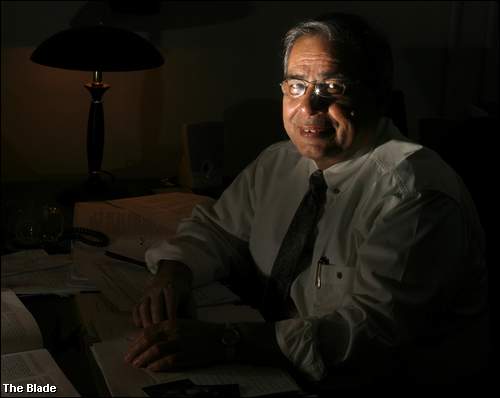Bishop Blair to Preside at Today's Ceremony
By David Yonke
Toledo Blade
May 20, 2006
http://toledoblade.com/apps/pbcs.dll/article?AID=/20060520/NEWS10/605200325
Anthony John Pistilli is confident he will be making the right decision when he approaches the altar today in Rosary Cathedral, where he will be ordained a deacon by Bishop Leonard Blair of the Toledo Catholic Diocese.
"When you discern this kind of ministry, it's something inside of you. God calls you to be in the family business and spread the Good News and help build the kingdom of God," said Mr. Pistilli, of St. Joseph's Parish, Sylvania.
He is one of nine candidates to be ordained permanent deacons in the diocese today.
 |
|
Alfredo Diaz is the vicar for deacons in the Toledo diocese, overseeing 183 deacons. Nine deacons are to be ordained today. Photo by The Blade/Jeremy Wadsworth |
"They're wonderful men with incredible talent and such a variety of interests and ministries," said Alfredo Diaz, the diocese's vicar for deacons. "I think they will be real assets to their parishes and to the diocese."
In addition to Mr. Pistilli, the deacon candidates are Gary Boudrie, also of St. Joseph's, Sylvania; James Caruso, of St. Patrick Historic, Toledo; Jeff Claar, of St. Mary Parish, Sandusky; Doyle Erford, of Holy Family Parish, New Cleveland, and St. Nicholas Parish, Miller City; Theodore Kaser, Jr., St. Rose, Lima; Leonard Roth, St. Joseph, Paulding; Daniel Waters, Our Lady of Perpetual Help, Toledo, and John Weeks, SS. Peter and Paul, Sandusky.
Mr. Diaz of Fremont has been a deacon since 1979 and was appointed vicar for deacons last year by Bishop Blair. Previously, the role of vicar for deacons was held jointly by the diocese's vicar for priests.
 |
| Bishop Blair |
There are 183 deacons in the 159 parishes that make up the Toledo diocese, not counting today's class of nine candidates, Mr. Diaz said, and 58 of them are on "senior status," or retired.
"Vicar basically means you speak in the name of the bishop," Mr. Diaz said. "There-fore I represent the bishop to the deacons."
While the number of priests in the Roman Catholic Church has been in a severe decline, forcing Bishop Blair and other bishops to close some parishes, deacons are not expected to carry the burden of the church's priest shortage, Mr. Diaz said.
"We try not to connect the shortage of priests with the diaconate. They are two different ministries," he said. "But the deacon should be in the parish and in the community, and they certainly provide some ministries that priests provide such as marriages and baptisms. They are a real help to the ministry of the parish priest and work together to see that the needs of the community are met."
Deacons played an active part in the early church but their role had fallen away over the centuries until it was revived after the Second Vatican Council in the 1960s.
The Toledo diocese began ordaining permanent deacons in 1973.
While men are studying to become priests, they are ordained deacons as a step toward the priesthood. In those cases, they are called transient deacons, Mr. Diaz explained.
Deacons serve a threefold role: love and justice, which is responding to the needs of the community; the Word, which is preaching, and the sacraments.
Liturgically, deacons can preside at weddings, baptisms, and wake services. They cannot celebrate Mass and the Eucharist nor the sacraments of penance or the anointing of the sick, Mr. Diaz explained.
A man must be 35 years or older to be considered for the diaconate and the process usually takes four years.
In Mr. Pistilli's case, however, it's been a slower path.
"They changed the program and there are six of us who say we're 'The Transition Boys,' " Mr. Pistilli said with a laugh. "Normally it's a four-year program, but six of us have been going through the program for 9 or 10 years."
Deacons can be married at ordination, but if their spouse dies they are then pledged to celibacy, Mr. Diaz said.
"That's one of the things we need to deal with as men are beginning to explore the life of the diaconate," he said.
The minimum age of 35 for deacons, set by the Vatican, is mostly because of the impact on families, according to Mr. Diaz.
"If they are married, at the age of 35 their children are older and they are able to understand the public ministry that this man commits to. It's really something that affects his life and the life of his family, and therefore the church takes that into consideration," Mr. Diaz said.
"The church doesn't want a young person, newly married, with very young children, because it could cause disruption in the family life."
He said he would like to see more deacon candidates who are closer to the minimum age.
"Our youngest deacon in the diocese right now is 43 or 44," Mr. Diaz said.
The deacons' ordination service will be at 11 a.m. today in Rosary Cathedral, 2535 Collingwood Blvd., with Bishop Blair presiding.
"It's getting closer and I am very excited," Mr. Pistilli said. "My stomach's trembling. But it'll all be fine. It is a very exciting time."
Contact David Yonke at:
dyonke@theblade.com
or 419-724-6154.
Any original material on these pages is copyright © BishopAccountability.org 2004. Reproduce freely with attribution.